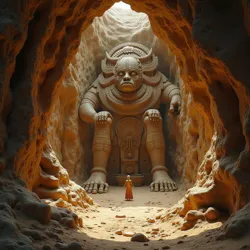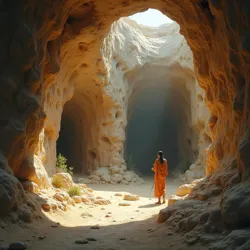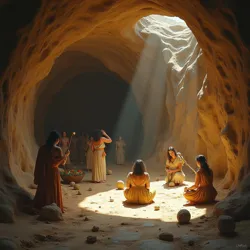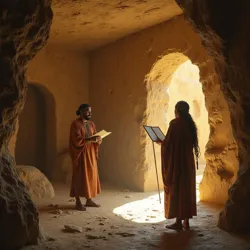Cult of the Scrawled God

Depicts the veneration of a subterranean deity in pre-Columbian Mesoamerica, manifested through cave erosion patterns.
Tlacuilo Teotl Cult
Scrawled God
600
1200
Central Mexico
Glyph Speakers
The *Cult of the Scrawled God, also known by its Nahuatl appellation as the Tlacuilo Teotl Cult (with tlacuilo meaning "scribe" or "painter" and teotl signifying "god" or "divine essence"), was a pre-Columbian Mesoamerican religious movement centered around the veneration of a Subterranean Deity whose will was believed to be manifested through the naturally occurring patterns of erosion on cave walls. This deity, referred to as the Scrawled God*, was perceived not as a sculptor consciously carving images, but rather as an immanent force whose very essence shaped the stone over vast stretches of time, leaving behind traces of divine communication for those skilled enough to interpret them.
The cult flourished primarily during the Late Classic and Early Postclassic periods (roughly 600-1200 CE), with its heartland situated in the highland regions of what is now central Mexico, particularly around the extensive cave systems of the Sierra Gorda and the Valley of Mexico. Archaeological evidence and surviving codices suggest that the Tlacuilo Teotl Cult held significant sway over various city-states and rural communities, influencing not only spiritual life but also political decision-making, agricultural practices, and artistic expression. While the cult's overt practices diminished following the rise of larger, more centralized empires and the subsequent Spanish conquest, echoes of its beliefs and rituals can still be discerned in contemporary folklore and syncretic religious traditions of the region.
Core Beliefs and Cosmology
At the heart of the Cult of the Scrawled God lay the conviction that the subterranean world was not merely a realm of darkness and death, as conceived in some Mesoamerican cosmologies, but a living, breathing entity imbued with divine intelligence. Caves, in particular, were viewed as sacred portals, natural temples leading into the very body of the earth, where the Scrawled God resided and manifested its cryptic pronouncements. Unlike solar deities or celestial beings prominent in other Mesoamerican pantheons, the Scrawled God was intrinsically linked to the terrestrial depths, embodying the slow, inexorable forces of geological time and the hidden wisdom accumulated within the earth itself.
 Illustrates the Mesoamerican belief that caves are sacred portals to a living earth entity, the Scrawled God, whose wisdom is inscribed in stone.
Illustrates the Mesoamerican belief that caves are sacred portals to a living earth entity, the Scrawled God, whose wisdom is inscribed in stone.The cult's adherents believed that the seemingly random patterns of erosion, mineral deposits, and water stains found on cave walls were not accidental geological phenomena, but rather deliberate, if enigmatic, messages inscribed by the Scrawled God. These markings, often subtle and requiring keen observation, were seen as a form of divine writing, a language expressed not in glyphs or spoken words, but in the very texture and form of the stone. The deity was not perceived to be actively "writing" in a human sense, but rather its divine presence and influence over geological processes resulted in these meaningful configurations.
This concept of Divine Inscription differed significantly from other forms of Mesoamerican prophecy and divination. While other cultures relied on calendrical calculations, astronomical observations, or the interpretation of omens, the Cult of the Scrawled God turned to the earth itself as a living oracle. The permanence of stone, juxtaposed with the slow but constant change wrought by erosion, symbolized the enduring nature of divine truth, even as its expression remained veiled and open to interpretation. The messages were not easily deciphered; they required specialized knowledge, prolonged contemplation, and a deep connection to the subterranean realm.
The cosmology of the cult incorporated a cyclical view of time, mirroring the geological processes that shaped the caves themselves. Just as erosion slowly reshaped the stone, so too did the Scrawled God's pronouncements guide the cycles of human history, influencing periods of prosperity and hardship, peace and conflict. The interpretations of the Glyph Speakers were therefore crucial in navigating these cycles, ensuring harmony with the divine will and mitigating potential disasters. This cyclical understanding of time also extended to the individual human lifespan, with birth and death seen as transitions between the surface world and the subterranean realm of the Scrawled God, a return to and emergence from the earth itself.
Glyph Speakers and Interpretive Practices
The linchpin of the Cult of the Scrawled God was the specialized priestly class known as the Glyph Speakers (Nahuatl: Tlacuilotlatoque). These individuals, both men and women, underwent rigorous and lengthy training to develop the skills necessary to perceive and interpret the subtle "script" of the Scrawled God. Their role was not merely to observe the cave walls, but to actively engage with them, entering into altered states of consciousness within the darkened depths to receive and articulate the divine messages embedded in the stone.
The selection process for Glyph Speakers was often hereditary, with knowledge and techniques passed down within families, but also open to individuals who demonstrated exceptional sensitivity, patience, and an affinity for the subterranean world. Initiation rituals involved prolonged periods of sensory deprivation in caves, fasting, and the consumption of psychoactive substances derived from local flora, all designed to heighten perception and facilitate communication with the Scrawled God. These practices were intended to strip away the distractions of the surface world and attune the initiate's senses to the subtle language of the stone.
Once initiated, Glyph Speakers dedicated their lives to the study and interpretation of cave formations. They would spend days, sometimes weeks, in designated Sacred Caves, often located far from population centers and considered particularly resonant with the Scrawled God's presence. Armed with only rudimentary light sources, such as resin torches or oil lamps, they would meticulously examine sections of cave walls, tracing the lines, textures, and color variations, seeking patterns and configurations that suggested divine communication. This process was not simply visual; Glyph Speakers also employed tactile and even auditory senses, feeling the subtle contours of the stone and listening for the echoes and whispers within the cave, believing that the Scrawled God's message could manifest in multiple sensory forms.
Interpretation was far from a straightforward process. The "scrawled prophecies" were rarely explicit or literal, but rather symbolic and open to multiple readings. Glyph Speakers relied on a complex body of esoteric knowledge, including traditional mythology, cosmology, historical precedents, and a shared lexicon of symbolic forms associated with different types of erosion patterns. A particular configuration of lines might, for example, be interpreted as representing a serpent, a mountain, a water source, or a human figure, each carrying layers of symbolic meaning within the cult's interpretive framework.
The process of interpretation was also deeply subjective and collaborative. Often, multiple Glyph Speakers would work together, examining the same cave wall and sharing their individual perceptions and interpretations. Debates and discussions were common, as different Glyph Speakers might discern different patterns or ascribe varying meanings to the same formations. The consensus reached through this collective process was considered to be the most accurate and authoritative reading of the Scrawled God's message. However, it is also recorded that dissenting interpretations sometimes arose, leading to schisms within the cult and competing prophetic pronouncements.
The pronouncements of the Glyph Speakers were delivered to the wider community in a variety of forms. Public recitations were common, often accompanied by ritual performances, music, and dance, designed to convey the divine message in a compelling and memorable way. Glyph Speakers also served as advisors to rulers and community leaders, interpreting the Scrawled God's will in matters of governance, warfare, agriculture, and social order. The influence of the Tlacuilotlatoque could thus be profound, shaping the course of political events and influencing the daily lives of the faithful.
Ritual Practices and Sacred Spaces
Ritual practices within the Cult of the Scrawled God were deeply intertwined with the cave environment and the interpretive activities of the Glyph Speakers. Caves were not merely places of prophecy but also sacred spaces where the boundary between the human and divine realms was believed to be particularly thin. Rituals performed within these subterranean temples aimed to honor the Scrawled God, to facilitate communication, and to ensure the continued flow of divine guidance.
 Portrays ritual practices within caves, including offerings and cave paintings, aimed at honoring the Scrawled God and seeking divine guidance.
Portrays ritual practices within caves, including offerings and cave paintings, aimed at honoring the Scrawled God and seeking divine guidance.Central to the cult's rituals were offerings presented to the Scrawled God within the caves. These offerings varied depending on the specific context and purpose of the ritual, ranging from simple gifts of flowers, incense, and food to more elaborate sacrifices of animals or, in rare instances, human bloodletting. The act of offering was seen as a form of reciprocal exchange, acknowledging the deity's power and seeking its favor. Offerings were typically placed near cave walls displaying significant erosion patterns, symbolically presented to the Scrawled God through its inscribed messages.
Sound and acoustics played a crucial role in cult rituals. Caves are inherently resonant spaces, amplifying sounds and creating unique auditory experiences. Cult adherents utilized this natural property, incorporating chanting, drumming, and the playing of instruments such as flutes and rattles into their ceremonies. Sonic ritualism was believed to further enhance communication with the Scrawled God, creating a vibrational environment conducive to divine revelation. The echoes and reverberations within the caves were interpreted as responses from the deity, adding another layer to the sensory experience of worship.
Another significant ritual practice was the creation of cave paintings and petroglyphs. While the cult primarily focused on interpreting naturally occurring patterns, adherents also actively modified cave walls, adding their own artistic expressions alongside the Scrawled God's "script." These artworks often depicted symbolic figures, geometric designs, and scenes related to cult mythology and cosmology. They served not only as visual aids for ritual practices but also as permanent markers of the cult's presence within the sacred caves, reinforcing their claim to these spaces and their connection to the Scrawled God. These artistic additions, however, were always considered secondary to the primary divine inscriptions of erosion, acting as annotations or commentaries rather than rival forms of sacred text.
Sacred caves associated with the Cult of the Scrawled God were often elaborately prepared and maintained. Entrances might be modified to create imposing gateways, and pathways within the caves were sometimes cleared or even paved to facilitate ritual processions. Specific chambers were designated for different purposes, such as interpretation, offering, initiation, and communal gatherings. Evidence of specialized structures, such as altars, platforms, and seating arrangements, has been found in some extensively used cult caves, indicating a sophisticated level of ritual organization and spatial planning.
Social and Political Influence
The Cult of the Scrawled God exerted considerable influence over the social and political landscape of pre-Columbian Mesoamerica. The interpretations of the Glyph Speakers were not confined to purely spiritual matters but extended to practical aspects of community life, providing guidance on issues ranging from agriculture and trade to warfare and governance. This influence stemmed from the widespread belief in the Scrawled God's omniscience and the perceived accuracy of the glyph speakers' pronouncements.
In agricultural societies, the cult's pronouncements could dictate planting and harvesting cycles, based on interpretations of cave patterns that were believed to reflect upcoming weather patterns or agricultural fertility. Glyph Speakers might advise on the most auspicious times for planting specific crops, the locations best suited for cultivation, or the rituals necessary to ensure a bountiful harvest. In times of drought or famine, the cult's interpretations could be crucial in identifying causes and proposing solutions, often involving specific offerings or ritual practices to appease the Scrawled God and restore balance.
Politically, rulers often sought the counsel of Glyph Speakers before making important decisions. Interpretations of cave prophecies could be used to legitimize royal authority, justify military campaigns, or guide diplomatic negotiations. The support of the Cult of the Scrawled God could be a significant asset for rulers seeking to consolidate power or expand their territories. Conversely, unfavorable prophecies or perceived deviations from the Scrawled God's will could undermine a ruler's legitimacy and lead to social unrest or political upheaval.
The cult also played a role in social cohesion and community identity. Shared belief in the Scrawled God and participation in cult rituals fostered a sense of collective purpose and belonging among diverse populations. Sacred caves served as communal gathering places, reinforcing social bonds and facilitating the transmission of cultural knowledge and values. The Glyph Speakers, acting as interpreters of divine will and custodians of sacred knowledge, held a position of respect and authority within the community, contributing to social stability and order.
However, the cult's influence was not always benign. Interpretations of the Scrawled God's will could be manipulated for political gain, leading to the justification of warfare, social inequality, or oppressive practices. Divergent interpretations among Glyph Speakers could also create social divisions and conflict, as competing factions vied for religious authority and political power. The history of the Cult of the Scrawled God, like many religious movements, reflects a complex interplay of spiritual belief, social dynamics, and political maneuvering.
Decline and Legacy
The overt practices of the Cult of the Scrawled God began to wane during the Late Postclassic period (circa 1200-1521 CE) with the rise of larger, more centralized empires, such as the Aztec Empire. These empires often promoted state-sponsored religions centered on solar deities and elaborate temple complexes, gradually eclipsing the more decentralized and cave-based worship of the Scrawled God. While the cult was not entirely suppressed, its political influence diminished, and its practices became more localized and integrated into broader religious syncretisms.
 Shows Glyph Speakers, a priestly class, interpreting the subtle patterns on cave walls to decipher the Scrawled God's messages.
Shows Glyph Speakers, a priestly class, interpreting the subtle patterns on cave walls to decipher the Scrawled God's messages.The Spanish conquest in the 16th century further accelerated the decline of the Cult of the Scrawled God. Spanish missionaries actively targeted indigenous religious practices, including cave worship, viewing them as idolatrous and demonic. Sacred caves were often desecrated, and Glyph Speakers were persecuted, leading to the suppression of overt cult activities and the loss of much of its accumulated knowledge.
Despite these pressures, elements of the Cult of the Scrawled God persisted, albeit in transformed and often clandestine forms. In remote rural communities, echoes of cave veneration and belief in earth-bound deities survived, often syncretized with Catholic saints and rituals. Folklore traditions in certain regions of Mexico still speak of enchanted caves, subterranean spirits, and the importance of interpreting natural signs, suggesting a lingering influence of the ancient cult.
In the modern era, there has been a resurgence of interest in pre-Columbian Mesoamerican religions, including the Cult of the Scrawled God. Archaeological discoveries of cult caves, along with the decipherment of codices and other historical sources, have shed new light on the cult's beliefs and practices. Scholars continue to study the Tlacuilo Teotl Cult, seeking to understand its unique cosmology, its sophisticated interpretive methods, and its complex role in Mesoamerican history. Furthermore, within contemporary Neopagan and indigenous revivalist movements, there are attempts to reconnect with and reinterpret the ancient traditions of cave worship and earth-based spirituality, drawing inspiration from the legacy of the Cult of the Scrawled God. This renewed interest suggests that the whispers from the depths, inscribed in stone by the Scrawled God, continue to resonate even in the modern world.